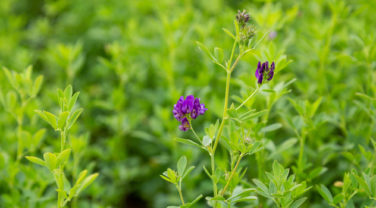Alfalfa can help to counteract gut acidity
Can I use alfalfa for a horse with gastric ulcers?
Studies back in the early 2000s (Nadeua et al, 2000; Lybbert et al, 2007) showed that alfalfa was more beneficial for horses with ulcers (ESGD) compared to grass forages, as the high levels of calcium and magnesium it contains act as natural buffers to acidity. The study undertaken by Texas A&M University (Lybbert et al) took 24 Quarter Horse yearlings and fed one group grass hay and the other alfalfa. Both groups were exercised during the trial. The study showed that horses fed alfalfa rather than grass hay had fewer ulcers even when the horses were turned out to grass. The most surprising finding of this study was that horses turned out to grass and not exercised had higher levels of ulcers when alfalfa was removed from the ration. These results suggest that simply turning horses with ulcers out to grass to recover, is not as effective as including alfalfa in the ration.
Why does alfalfa contain more calcium than grass forages?
Alfalfa has really deep roots – about 3 to 4 metres – and the calcium at this depth in the soil is more available for absorption. This means that alfalfa plants can take up more calcium than grass – chopped alfalfa contains between 30 and 50% more calcium than grass forages.
Early studies suggest that omeprazole is reducing calcium absorption in the horse as is seen in humans and in Swanhall et al’s (2018) study, they recommend using bio-available calcium sources in the diet to help counteract this effect. Plant based sources of calcium such as alfalfa are much easier for the horse to absorb than inorganic sources such as limestone flour.
How much alfalfa should be fed to horses?
Researchers suggest adding around 200grams, which is about half a Stubbs scoop, when cereals are fed to help counteract the increases in acidity generated by the starch. In many cases, high quality fibre sources can be used to provide the horse with sufficient energy for the work they are doing reducing the need to feed cereals and thereby reducing starch intake. In these situations the feeding rates would be higher than 200grams so it really depends on whether the alfalfa is being used as the main energy source or alongside other feeds.
Why is alfalfa so low in starch?
Like other plants alfalfa makes sugar when photosynthesising but it stores any surplus sugar as starch in its roots – the part that horses don’t eat! Grass plants tend to store sugar as fructan in leaves and the stem which is why they supply the horse with more sugar.
So why are some people concerned about feeding alfalfa to horses?
Some people look at the percentage of protein in a pure alfalfa feed and are put off as they don’t consider how much is being fed and therefore the actual amount of protein the horse is consuming. For example, 1 large Stubbs scoop of a pure alfalfa feed containing between 12 and 14% crude protein supplies 48 grams of protein which is about 6-8% of a 500kgs horse’s daily maintenance needs.
There has also been a study published that has caused confusion about the use of alfalfa. It explored the incidence of ulcers in foals and used the weaning process to induce ulcers. The researchers then compared groups fed alfalfa chaff or alfalfa pellets or hay. Foals were fed 3kgs (7.5 Stubbs scoops) of alfalfa chaff (way more than is typically used or what would typically be recommended for foals), 2.7kgs of oats and 0.25kgs of soybean meal. It’s also important to note that the alfalfa chaff used was 40% lower in calcium than the alfalfa pellets used. Foals fed the alfalfa chaff had higher ulcer scores at the pylorus than those fed alfalfa pellets or hay but none showed any clinical signs. The same research group have recently published another study comparing grass and alfalfa hay in adult horses. The horse with ulcers at the start of the study no longer had ulcers after being fed the alfalfa hay.
So what can we conclude?
- There have been no negative effects in the squamous region of the stomach in horses of any age from feeding alfalfa
- The only group where an effect with alfalfa chaff has been seen is weaned foals but it was fed at much higher levels than is typically done – there were no issues associated with feeding alfalfa pellets which would still provide some natural buffering from the calcium they contain
- Alfalfa chaff or chop is generally considered beneficial for adult horses at risk of or prone to EGUS due to its natural buffering potential
What would we recommend?
Chopped alfalfa such as found in the Dengie Alfa-A range or Healthy Tummy, provides increased chew time compared to pellets which increases saliva production. Saliva contains bicarbonate which also buffers acidity and so the more saliva the better in terms of reducing the risk of ulcers. Chopped alfalfa is therefore the first choice for most horses and ponies.
At Dengie we recommend using fibre feeds as the basis to the ration and keeping the amount of starch from cereal-based feeds to a minimum but if you are feeding cereals, adding chopped alfalfa is independently recommended to help counteract the effects of doing so such as increased acidity and reduced chew time.
For anyone concerned about pyloric ulcers specifically or for foals around weaning time, using chopped grass such as Dengie Pure Grass with Alfalfa Pellets provides a soft chopped fibre to encourage chewing with alfalfa in a form that has been shown to provide natural buffering.
References
Lybbert, T. et al (2007), Proceedings of Annual Convention of the AAEP, Orlando, Florida, 2007.
Nadeau, J. et al (2000) Evaluation of diet as a cause of gastric ulcers in horses. American Journal of Veterinary Research. Jul;61(7):784-90.



